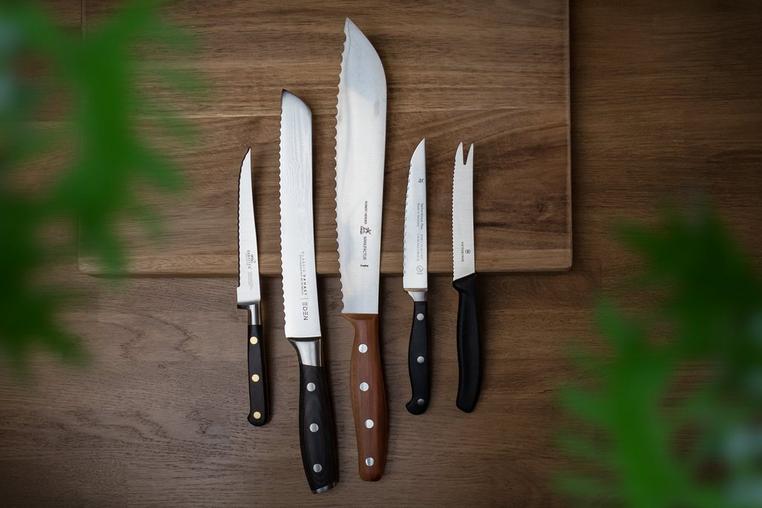What do you need to know about serrated knives?
Within the kitchen knife world serrated knives do not really fit in. For many a serrated knife equals a bread knife, but is this really true? When do you call something a serrated knife? And what is the use of the pointed edges? We would love to tell you all about it in this article.
What are serrated knives?
Serrated knives are knives of which the edge is enhanced with small serrations. The best-known example is the bread knife: a knife with an elongated and narrow blade that is rounded at the front and, as said before, has a serrated edge. But also table knives, peeling knives, butter knives, tomato knives, sausage knives and baker’s knives can be enhanced with serrations. For some of these knives the serrations are the norm, for others it is mostly a rare alternative for a smooth edge.
What do you use a serrated knife for?
Serrated knives are mostly used to cut products with a hard outside and a softer inside. A baguette is probably the first thing you think of right now. But also other types of bread, cakes and pies can best be cut with a serrated knife. The same applies to pizzas – if you don’t have a pizza cutter, which is also serrated. Or think about pineapples: you won’t easily cut through it by using a plain edge knife.
Serrated knives are also perfect when cutting ‘sponge-like’ vegetables, such as tomatoes. There are also special tomato knives which are sometimes also called sausage knives. A piece of dried sausage is easy to cut with a serrated knife. But there are, probably many more examples of foods that can be cut with this type of knife. The most important question, however, is: why do you use a serrated knife for these tasks instead of a plain edge knife?
Why is a serrated knife sometimes more suited than a plain edge knife?
The main advantage of a serrated knife is that you don’t have to apply too much pressure when cutting. The serrations, after all, do the work for you. By moving the knife back and forth it will automatically dig itself further in the product until it has reached the base. As a result the cutting technique is very different then when you, for instance, ‘rock’ a chef’s knife. With a serrated knife you won’t be able to immediately cut through a product. In exchange, however, you get a lot a more grip, which is key when cutting the abovementioned products.
Ever tried to cut a tomato with an average peeling knife? Especially when you are not using a razor-sharp knife you will quickly squish the tomato. You will lose the juices inside and it is dangerous. You are inclined to apply more pressure and when the knife slips you can really hurt yourself. However, if you use a serrated knife the shape of the tomato will remain intact enabling you to cut nice, even slices.
When we look at bread, cake, pies and such, the serrated knife will mostly ensure that you won’t have as much crumbs and that you don’t squish the product. How much crumbs you end up with also with depends on the quality of the knife. What makes a serrated knife a good serrated knife? You will read all about it below.
What are the characteristics of a good serrated knife?
There are a lot of differences between serrated knives. There are, for instance, serrated knives with razor-sharp teeth, while others have slightly more rounded tips. In addition, some knives have more serrations than others, even if the length of the blade is slightly similar. And also the depth of the space in between the serrations – let’s call them slots – differs.
A good serrated knife has razor-sharp serrations. These serrations will offer you more grip and enable you to use less force. The reason why some serrated knives have rounded tips is to make sure they don’t wear out as quickly. However, if you are looking for optimal cutting pleasure you should choose a serrated knife with razor-sharp tips.
The depth of the slots in between the serrations also influences how much grip you will have. The deeper the slot, the larger the surface of the teeth. This gives you more grip: the knife will cut through the bread, tomato or any type of product much easier.
The number of serrations is also key. We believe that the less serrations the better. The contact surface per serration will, after all, be better, ensuring that each individual serration applies more pressure. The result is that a serrated knife with less serrations will cut deeper than a knife that has many serrations.
In short: do you want to purchase a good serrated knife? Choose one with a relatively small amount of razor-sharp, pointed serrations, with a deep slot in between.
Sharpening a serrated knife? Easy!
You can easily sharpen a serrated knife. For it you use a sharpening steel or sharpening stone with a rounded edge. Do this occasionally to make sure your knife stays in great shape. Want to learn more? Read our topic: How do I sharpen a bread knife?. The content can be used to sharpen any type of serrated knife! Not only bread knives.









?%24center=center&%24poi=poi&%24product-image%24=&fmt=auto&h=500&poi=%7B%24this.metadata.pointOfInterest.x%7D%2C%7B%24this.metadata.pointOfInterest.y%7D%2C%7B%24this.metadata.pointOfInterest.w%7D%2C%7B%24this.metadata.pointOfInterest.h%7D&scaleFit=%7B%28%24this.metadata.pointOfInterest%29%3F%24poi%3A%24center%7D&sm=c&w=1208)